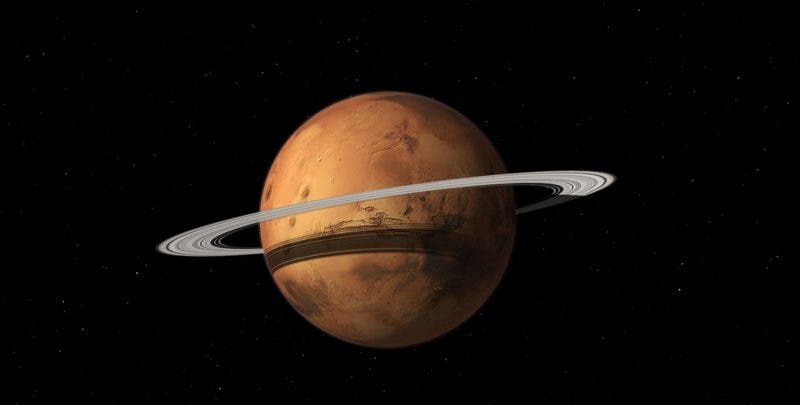
Astronomers have recently proposed an intriguing hypothesis: Mars may have had planetary rings formed by the crumbling remnants of one of its ancient moons, now long gone. The same ancient moon may have seeded the Red Planet’s sole surviving pair of moons: Phobos and Deimos.
Put a ring on it
Don’t be jealous of Mars. While it has two moons (unlike Earth, which has only one), these are tiny and not that much to look at. Phobos, whose name comes from the Greek phobia (fear), is just 22.7-km across while Deimos, which in Greek mythology is the twin brother of Phobos and personified terror, measures a measly 12.6-km in a diameter. So much for the fear factor.
Due to their small size, astronomers used to believe for a long time that Phobos and Deimos were actually wandering asteroids that were captured by Mars’ gravity. However, subsequent observations showed that their obits are almost in the same plane as the Red Planet’s equator, meaning the moons must have formed at the same time as Mars.
It is this ‘almost’ that has been bugging scientists for quite some time, leading Matija Ćuk, a research scientist at the SETI Institute, to formulate a wild hypothesis.
For Ćuk, what’s really intriguing about these puny moons is not their size, but rather their orbital motion. Phobos orbits just 9.377 kilometers above the Martian surface, circling the planet three times in a single Earthling day. And, with each orbit, Phobos is drawing nearer to Mars, tugged by the planet’s overwhelming force of gravity.
In 2017, Ćuk, along with David Minton, a professor at Purdue University, and then-graduate student Andrew Hesselbrock, published a paper suggesting that Phobos will eventually get pulled apart by Mars’ gravity, spewing debris that will go on to form a ring around the planet. This wouldn’t be the first time either.
The researchers’ models suggest that over the course of Mars’ geological history, many Martian moons were destroyed in this manner, and each time a new, smaller moon would form. This ring-moon cycle repeats over and over again.
In their most recent study, which was presented at the 236th Meeting of the American Astronomical Society, held virtually on June 1-3, 2020 due to COVID-19 concerns, Ćuk and colleagues provide new insights to support their ring-moon formation theory.
This time, their thesis centers on Deimos, the smallest and most distant of the two Martian moons. What’s odd about Deimos is that its orbit is tilted by two degrees.
“The fact that Deimos’s orbit is not exactly in plane with Mars’s equator was considered unimportant, and nobody cared to try to explain it,” Ćuk said in a statement.
“But once we had a big new idea and we looked at it with new eyes, Deimos’s orbital tilt revealed its big secret.”

The researchers claim that Deimos’ tilt can only be explained by the existence of a ‘grandparent’ moon, roughly 20 times larger than Phobos. This ancient moon, thought to have existed 3 billion years ago, likely broke up and reformed twice, creating Phobos in the process the second time around. Each time it broke, the grand-moon also produced planetary rings.
The grandchildren of this sizable, long-gone moon would have migrated outwards, pushed by a planetary ring, strongly affecting Deimos’ orbit in the process.
Deimos is thought to be billions of years old, while Phobos is much younger, having formed just 200 million years ago, during the time of the dinosaurs. Their timeline fits well with the researchers’ ring-moon cycle theory.
All of this implies a striking image: billions of years ago, Mars may have had a prominent ring.
But as intellectually fascinating this might sound, there is little evidence to support the researchers’ assertions. Their theory might be put to the test when JAXA, the Japanese space agency, lands a spacecraft on Phobos, a mission slated for 2024. The spacecraft will touch down with the Martian moon, collect samples, and return them back to Earth for analysis. Inside these samples, scientists hope to find telltale clues about Mars’ past.
“I do theoretical calculations for a living, and they are good, but getting them tested against the real world now and then is even better,” Ćuk hopefully remarked.









